Savoring the City of Charleston
A change in plans leads to a road trip to one of America’s favorite cities
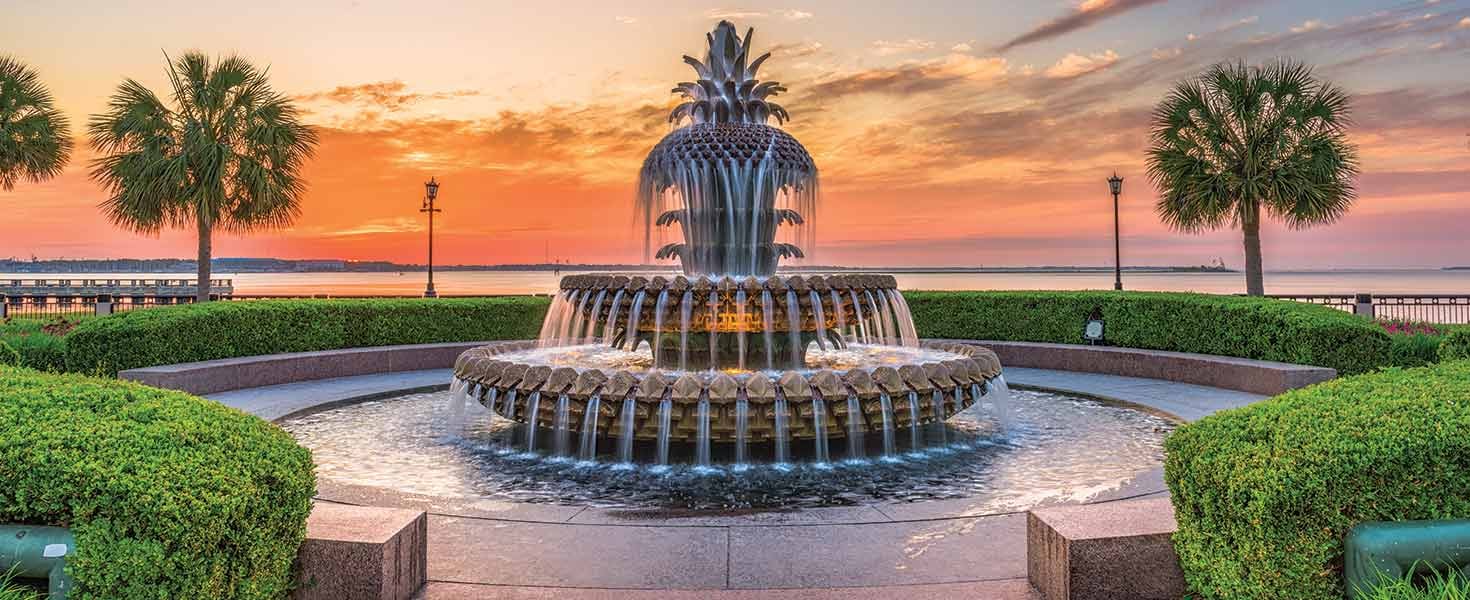
Pictured above: Joe Riley Waterfront Park features a pineapple fountain, a symbol of hospitality.
I had been planning a bucket-list vacation with my husband, John, this year: three leisurely days in Paris followed by a river cruise through Provence during peak lavender season. In anticipation, we watched every Netflix show that included the word “France,” read about French history and culture, and even downloaded an app to learn a few French phrases. Alas, like everyone else, our plans were interrupted by the pandemic.
We experienced the four classic phases of travel cancellation grief: reeling (No, this can’t be happening after watching all 30 episodes of Versailles!), feeling (Who says we can’t go? It’s our right to travel wherever we want to!), dealing (OK, just rebook us for July. OK, for August. Will the lavender still be in bloom in September?), and finally, healing (We’re just not going to make it to France this year.). Once the anguish of cancelling the trip was over, we felt a void with no vacation to look forward to. So, we started thinking about what we could do instead. We pulled out a map (yes, we still use paper maps at our house) and decided to take a drive trip. How hopeful we felt about traveling again just by looking at a US map and seeing all the places we could go!
Our decision on the destination was made when we learned that, for the eighth consecutive year, Charleston, South Carolina, was named the number-one city in the US in Travel + Leisure’s World’s Best awards survey. We set our date, packed the car (including plenty of hand sanitizer, antibacterial wipes and washable masks) and headed to Charleston.
AUNTIE EM’S PLACE
From our home in Southeastern Pennsylvania, we drove 600
miles south to Charleston, where we pulled up at Emeline, one
of city’s newest boutique hotels. The hotel manager and “living
room host,” Tom, invited us into the living room (lobby) filled
with vintage furnishings, local art and interesting curiosities for
contemplation, including history books, a stuffed squirrel, and
a collection of driftwood and seashells. An exotic sandalwood
scent drifted through the space in harmony with the lively jazz
wafting from a turntable. Emeline felt like a visit to a welltraveled
rich aunt’s townhouse, and she was eager to make us
feel welcomed.
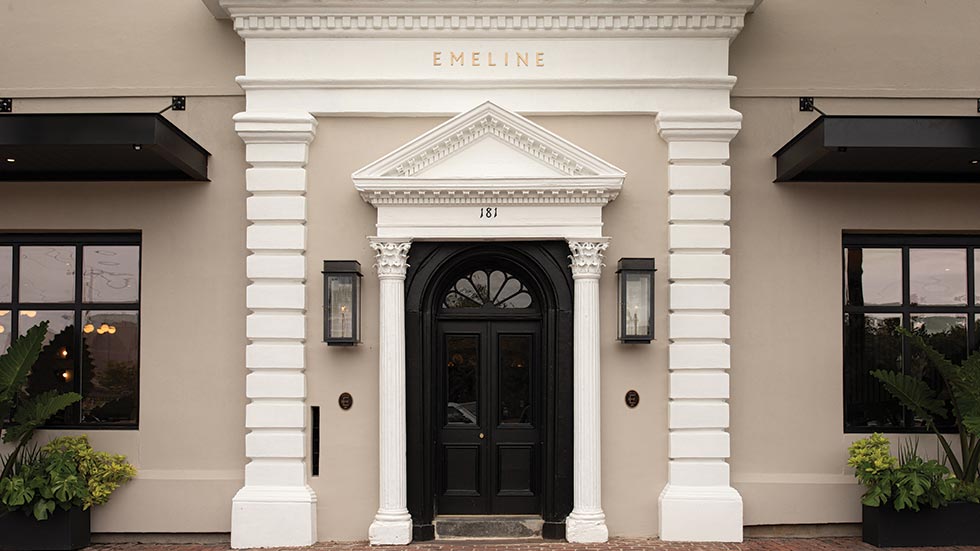
Hotel Emeline
Photo By Lindsey Shorter/Courtesy Of Emeline
When we entered our Collector’s Suite room, a 331/3 rpm album of Emeline’s own curated music, a blend of new and old blues, was playing on a Crosley turntable. Indigo walls offset the mustard-colored drapes in the living area; the separate sleeping area in comforting shades of gray featured a king bed made up in custom-embroidered white linen sheets. An oversize soaking tub and signature-scented bath amenities in the attached bathroom made it feel as if we had our own private spa. We were reluctant to leave, but our dinner reservations were booked. So we got dressed and ventured out into the city.
ZERO GEORGE, YOU’RE A TEN (MAKE THAT AN ELEVEN)
Emeline’s location just steps away from Charleston’s City Market
meant we could walk most everywhere. We followed the brick
sidewalk about a half-mile to Zero Restaurant + Bar, housed
in a restored 1808 building. Our table for two overlooked the charming courtyard, with the other tables appropriately spaced
apart. We selected the 11-course wine-and-food tasting menu.
Our server told us that the first few plates would come out
quickly, and she was right: fresh veggies in shishito pepper
ranch dip; red prawns in green garlic sauce; crunchy tostada
bites with smoked trout roe; broiled oysters with fig leaf and
blueberry; and delicata squash with smoked salmon paired with
Bordeaux blanc were all delivered within the first 30 minutes.
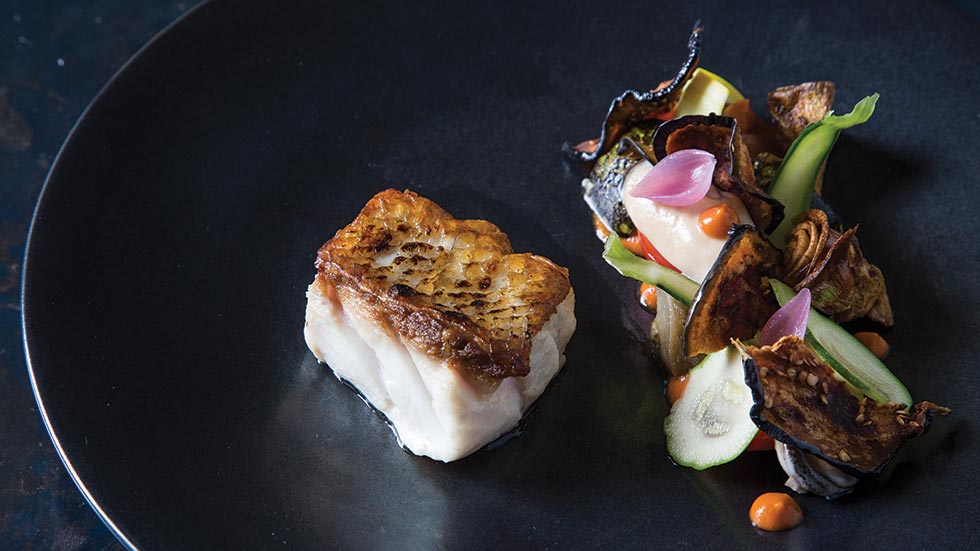
Red snapper at Zero George Restaurant + Bar
Photo By Jonathan Boncek
From there, the pace of delivery slowed significantly, and we were delighted over the next two hours with each new flavor sensation. The dinner ended with a ruby port paired with a caramelized brioche covered in salted chocolate that, I’m almost ashamed to say, I couldn’t even eat because I was so full. We were grateful for the walk back to our hotel through quiet streets in the sultry night air, past 18th-century churches and
ROLLING RIGHT ALONG
The following morning, our alarm clock was
a low rumble of distant thunder in an
otherwise clear sky. We had slept later
than planned, so we hurried to meet
our ship for the 10:30 a.m. harbor tour
aboard the Carolina Belle. We sat in the
bow for a 90-minute narrated tour that
was both informative and humorous
as the captain pointed out the sights
along the Cooper River. We cruised past
Waterfront Park with its famed pineapple
fountain, along the picturesque East Battery
with its colorful mansions, and past
Fort Sumter, where the American Civil War was
sparked.
As carefree dolphins led the ship for a time, we sailed past Patriots Point Naval & Maritime Museum, home of the legendary aircraft carrier USS Yorktown and a fleet of other National Historic Landmark ships. Finally, we cruised under the two-and-a-half-mile-long Arthur Ravenel Jr. Bridge connecting downtown Charleston and Mount Pleasant, where the captain gleefully tested the ship’s horn (three times) to experience the echo under one of the world’s longest cable-stayed bridges.
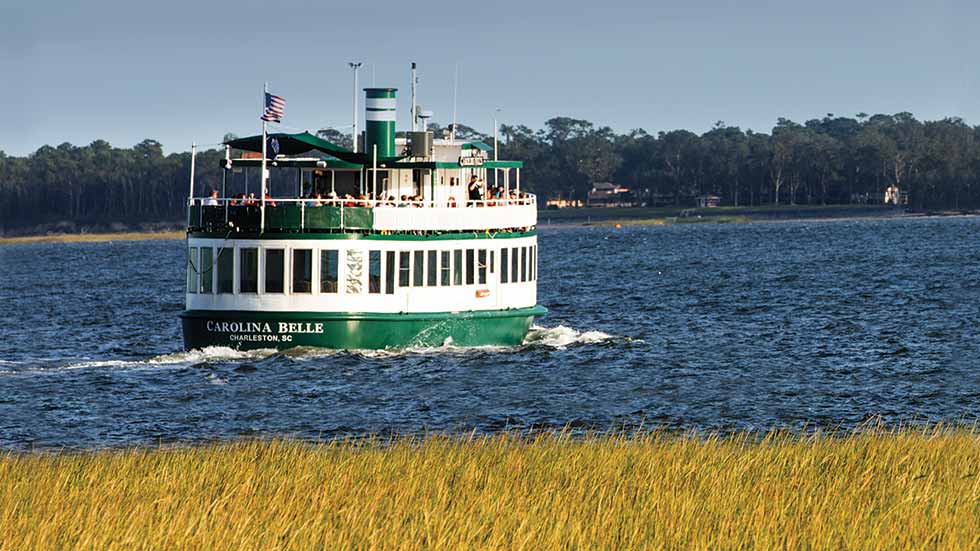
The Carolina Belle
Courtesy Of Charleston Tours & Events
With our appetites revived by the salt air, we disembarked and walked to Charleston Crab House for a taste of its famous shecrab soup and IPAs from Holy City Brewing, one of more than 30 microbreweries in the greater Charleston area. Sufficiently refreshed, we crossed the street to stroll through City Market, a landmark since 1804 housing more than 300 vendors. Due to the pandemic, many of the vendors’ stalls were vacant, but those that were open were operated by cheerful merchants (appropriately masked and distanced), all of whom were grateful to see tourists. From there, we wandered through the easy-to-navigate city, most of which is a beautifully preserved National Historic Landmark District, with block after block of 18th- and 19th-century churches, homes and buildings.
ANOTHER DAY, ANOTHER DINNER
After a day of sightseeing, we stopped for a cold drink at our
hotel’s restaurant, Frannie and the Fox. Our server, Josh, took
a real interest in asking what we planned to do during our
stay. After delivering our drinks, he came back a few minutes
later with a written list of his personal recommendations for
unique experiences in the area. We were delighted with this
unexpected touch of hospitality and local insight.
Josh’s passion for the area’s hot spots turned to a discussion
of Frannie and the Fox’s menu, and we soon found ourselves
savoring shared plates of delicate blue crab fritters
and heirloom tomato toast brimming with
burrata and fresh basil. Between bites, John
and I locked eyes, realizing that we had
promised to meet up with friends at
legendary Lewis Barbecue for dinner in
just about an hour. Could we possibly
fit in another meal?
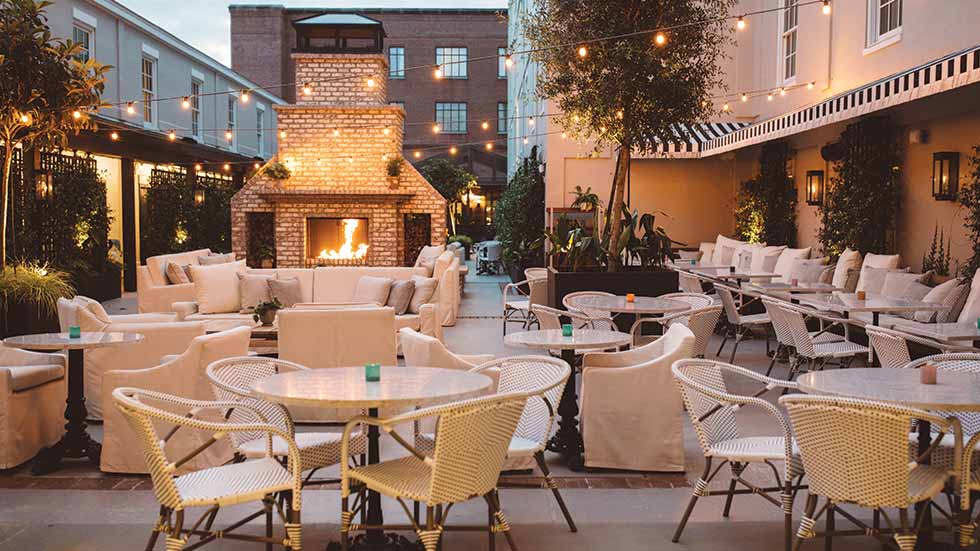
Courtyard dining at Frannie and the Fox
Photo By Lindsey Shorter/ Courtesy Of Emeline
Of course, dear reader, you already know the answer to that question. We drove 10 minutes to North Charleston and got in line with the locals at Lewis Barbecue, known for its custom-built Texas smokers and award-winning secret smoke flavor. We ordered brisket, pulled pork and cold beers, and then we took our platters outside to a picnic table under a massive tree. We enjoyed the food, the company and the live entertainment but declined dessert, as we were just too full to eat more.
Once we were back at the hotel, though, we found a new spark of energy. It was Saturday night, and more people were in town strolling the streets on this midsummer night. In the waterfront park, we sat for a while on a swinging bench overlooking the Cooper River and jokingly lamented that we had missed dessert. It was then that we smelled chocolate and followed the scent to Carmella’s, a trendy late-night dessert café with a full bar. We ordered salted caramel gelato and a toffee brownie to celebrate. After all, how many times can you say that you ate at five different venues in one day?
ALOHA, Y’ALL
One of Charleston’s charms is its proximity to the Atlantic
Ocean, so the next morning, we drove 12 miles south to Folly Beach, a bohemian town known for its massive 1,045-footlong
fishing pier jutting into the ocean from a wide sand beach
that reaches like two tanned arms in either direction. I’d like
to say that we came to Folly Beach for a day in the sun, but by
now, you’ve probably guessed that it was a restaurant that drew
John and me to this little village resembling the set of a 1960s
beach party movie.
Our scene for lunch was Wiki Wiki Sandbar, a Hawaiian-themed, treehouse-like venue complete with a giant papier-mâché octopus hanging from the ceiling and cocktails in plastic tiki cups with little pink umbrellas. We half-expected to see Elvis at the bar enjoying the oddly sensible combination of Southern hospitality and Aloha spirit.
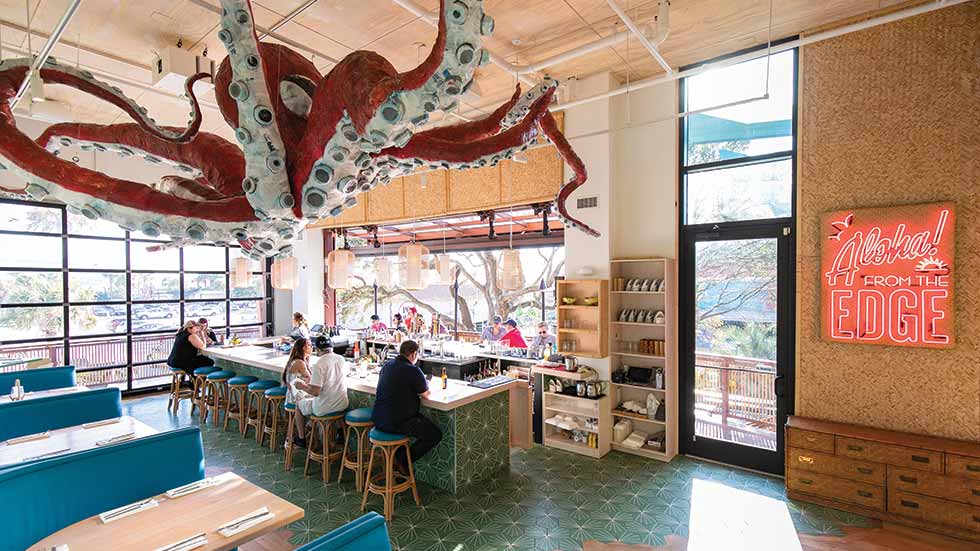
Wiki Wiki’s indoor space features a large octopus sculpture
Photo By Leslie Ryann Mckellar Photo By Leslie Ryann Mckellar
Our server welcomed us with “Aloha, y’all” and then told us about the house specialty: Spam sliders. Seeing our hesitation, she offered to pay for them if we didn’t love them. Her triedand- true sales technique sold us, and we weren’t disappointed. The Spam had been marinated overnight in fresh pineapple juice, pressed into brown sugar and grilled, and served with a dill pickle on a Hawaiian roll with spicy aioli. We didn’t see Elvis, but we did have fun sharing stories about the last time we’d willingly eaten Spam.
From Folly Beach, we drove across the Ravenel Bridge to Boone Hall Plantation, a working farm since 1681. We toured the mansion, built in 1936, and then boarded a tractor-drawn wagon for a ride along the farm’s perimeter. The plantation’s historic slave cabins (circa 1790–1810) have exhibits representing different eras of African American history, including one demonstrating what life was like for slaves on a working plantation, one dedicated to Emancipation and another to the Civil Rights Movement.
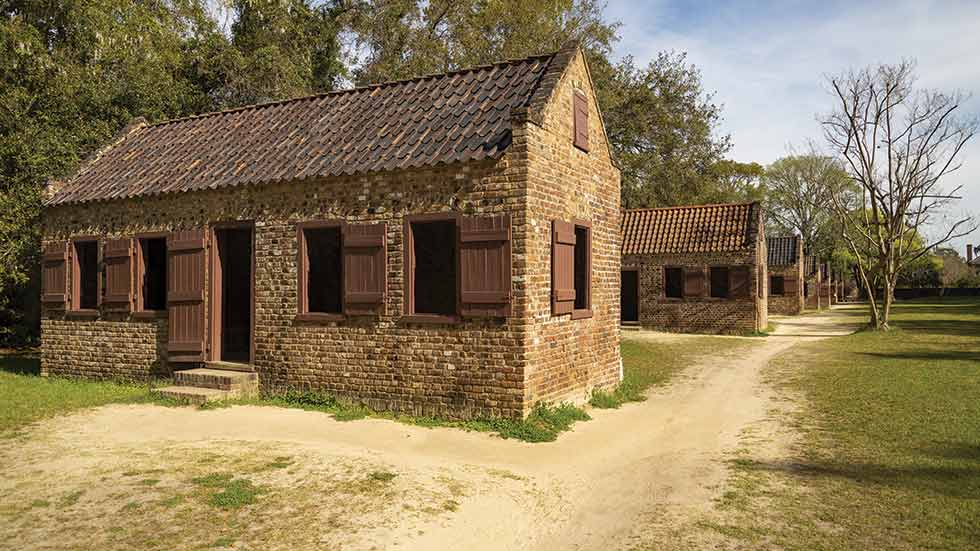
Former slave quarters at Boone Hall Plantation have exhibits on Black history in the US
Photo By Enrico Della Pietra/Stock.Adobe.com
The last of the nine cabins was dedicated to the traditions of the Gullah people, African Americans descended from slaves who have a language and culture unique to the Lowcountry. Like many other preserved historic sites in and around Charleston, a city where an estimated 40 percent of all enslaved Africans entered the US for the first time, Boone Hall strives to educate visitors about the human toll of slavery by sharing true stories of both important historical figures and everyday folks.
In 2018, the city of Charleston formally apologized for its role in the slave trade, and it is now focused on promoting economic equality and racial reconciliation.
TO THE FINISH LINE
Back in town that evening, we eagerly anticipated the dining
highlight of our trip: Magnolia’s Uptown Down South, one of
the city’s most popular restaurants and a trendsetter in creating
traditional Lowcountry meals with contemporary twists using
fresh local ingredients.
Once again, our server charmed us with a friendly wager about the best appetizer on the menu, so we started with fried green tomatoes lightly battered and set on cheddary grits surrounded by a pool of tomato butter. We could have stopped there because it was so good, but of course, we didn’t. My entrée was fresh-caught grouper with lemon caper butter, local green beans and whipped potatoes; John had the parmesan-crusted flounder topped with sweet corn and asparagus and a side of shrimp pirloo, a flavorful Lowcountry rice dish that’s considered a staple on Southern menus. Dessert was offered—bourbon pecan pie, vanilla bean crème brûlée and key lime tart among the choices—but again, we could not eat anything else. Missing that pie remains the biggest regret of my vacation.
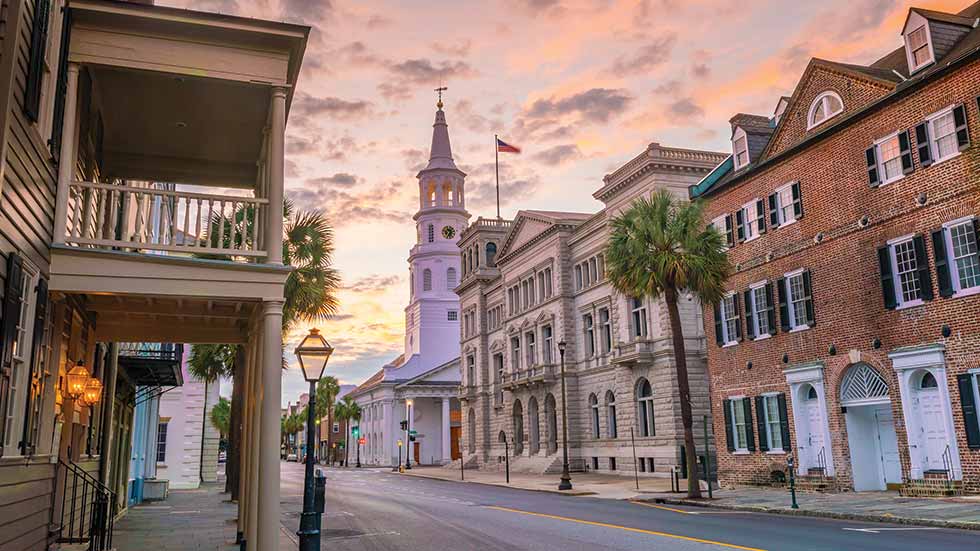
Charleston retains many 18th- and 19th-century buildings.
ON THE ROAD AGAIN
Aside from eating fabulous food for days on end, our trip
to South Carolina was a very different vacation from the
French river cruise we had planned—and not just because of
the destination. Who would have thought we’d be wearing
masks to tour one of our country’s best cities?
The upside of vacationing in the time of COVID-19: fewer crowds and friendly, grateful service; easy-to-get reservations at the most popular restaurants; and an overall feeling of normalcy in a world that can sometimes feel less than real. For someone like me who makes a living writing about travel, it was a relief to find people touring, tasting, learning and discovering. Travel allows us to satisfy one need that every human has in common: the need to connect. So when you are ready, places like Charleston are waiting to welcome you. Just wear a mask, have a plan, and—oh, yes—go for that last piece of pie. We’ve all earned it.
